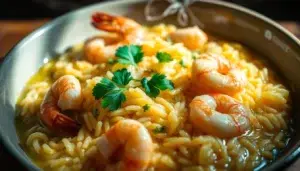Imagine being in a cozy Italian trattoria. The rustic decor and the smell of seafood risotto fill the air. The creamy risotto and tender fresh seafood flavors make for a truly Italian experience.

Making an authentic Italian seafood risotto is a journey. It needs patience, quality ingredients, and skill. This dish, from Italy’s north, is loved worldwide. As you make this seafood risotto recipe, you’ll learn about Italian flavors and traditions.
Key Takeaways
- Understand the significance of risotto in Italian cuisine.
- Learn the essential ingredients for an authentic seafood risotto.
- Discover the importance of using fresh seafood.
- Get tips on achieving the perfect creamy risotto texture.
- Explore the traditional Italian cooking techniques involved.
The Rich Heritage of Italian Seafood Risotto
Every bite of a well-made seafood risotto tells a story of Italy’s rich heritage. This beloved dish comes from Italy’s northern regions. It shows the country’s deep love for food.
Origins of Risotto in Italian Cuisine
Risotto started in the north of Italy, in the Piedmont region. It was first made with barley or rice from the area. By the 18th century, it became a key part of Italian food, thanks to Arborio rice.
Chefs perfected the way to cook risotto over time. They learned to stir it in a special way, called all’onda. This makes the dish creamy and smooth.
Regional Variations of Seafood Risotto
Seafood risotto changes a lot from one region to another in Italy. This shows the local seafood and traditions. For example, in Liguria and Veneto, you’ll find risottos with shrimp, mussels, and clams.
In other places, different seafood is used. This highlights the variety and richness of Italian seafood dishes. Knowing these differences can help you make your own special seafood risotto.
Essential Ingredients for an Authentic Recipe for Seafood Risotto Italian Style
Making a true Italian seafood risotto starts with picking the best ingredients. The quality of your dish depends on the freshness and authenticity of what you choose.
Selecting the Perfect Rice
The base of a great risotto is its rice. Italian cooking uses special types of rice for risotto because of their unique qualities.
Arborio vs. Carnaroli vs. Vialone Nano
You have three main rice options: Arborio, Carnaroli, and Vialone Nano. Arborio is common and works well. But Carnaroli is often better because it has more starch and a firmer texture. Vialone Nano is also great, known for soaking up flavors well.
Fresh Seafood Selection Guide
For a real seafood risotto, fresh seafood is key. Choose what’s fresh and available in your area.
Shellfish Options
Good shellfish choices are shrimp, scallops, and clams. Make sure they’re sustainably caught and handled well.
Finfish Recommendations
Halibut or sea bass are great for finfish. They add flavor and texture. Choose high-quality finfish, cut right for even cooking.
Key Aromatics and Seasonings
Onions, garlic, and white wine are key for flavor in your risotto. Season with sea salt and freshly ground black pepper. Add fresh herbs like parsley for a bright taste.

Equipment and Preparation
Getting your kitchen ready is key to making a tasty seafood risotto. You’ll need the right tools and to know how to prep your seafood.
Essential Kitchen Tools
To make an easy seafood risotto recipe, you’ll need some basic tools. You’ll need a big, heavy pot or Dutch oven, a wooden spoon or spatula, a fine-mesh strainer, and a cutting board. Having these tools ready makes cooking easier.
Preparing Your Seafood
It’s important to prepare your seafood right when learning how to make seafood risotto. This includes cleaning shellfish, preparing fish fillets, and making seafood stock.
Cleaning Shellfish Properly
Rinse shellfish under cold water, scrubbing them to remove grit or sand. Throw away any broken or open shells.
Preparing Fish Fillets
Pat fish fillets dry with a paper towel and cut them into the right sizes for your risotto.
Making Seafood Stock
Simmer seafood shells, fish bones, and aromatics in water or white wine to make a tasty seafood stock. Strain it before using.

Step-by-Step Cooking Process
Now that you have your ingredients, it’s time to start making a tasty seafood risotto Italian style. This journey has several important steps. You’ll need to pay close attention and be patient.
Creating the Flavor Base
The base of a great risotto is its flavor. This comes from sautéing aromatics and toasting the rice.
Sautéing Aromatics
Start by heating olive oil in a big pan over medium heat. Add chopped onions and cook until they’re clear. Be careful not to let them turn brown. This step is key for the flavor.
Toasting the Rice
Then, add the Arborio rice to the pan. Stir it constantly for 1-2 minutes. The rice should be coated in oil and lightly toasted. This helps it soak up the liquid better.
The Art of Adding Liquid Gradually
Adding liquid bit by bit makes the risotto creamy. This step needs constant stirring and patience.
Proper Stirring Technique
Stir the risotto gently but constantly. This ensures the rice cooks evenly and absorbs the liquid well.
Monitoring Consistency
As you add broth, check the risotto’s consistency. It should be creamy but still firm in the center.
Incorporating the Seafood
Add the seafood towards the end. This keeps its texture and flavor.
Timing for Different Seafood Types
Seafood cooking times vary. Shrimp and scallops cook fast, while mussels and clams take longer. Adjust your timing.
Final Seasoning Adjustments
After cooking the seafood and when the risotto is just right, adjust the seasoning. You might need more salt, pepper, or lemon juice.
Achieving the Perfect “All’onda” Texture
The “all’onda” texture means the risotto flows like a wave when stirred. This is a sign of a perfectly cooked dish.
| Seafood Type | Cooking Time | Tips |
|---|---|---|
| Shrimp | 2-3 minutes | Add towards the end to prevent overcooking |
| Mussels | 5 minutes | Ensure they are scrubbed and debearded |
| Scallops | 2-3 minutes per side | Pat dry before adding to risotto |
By following these steps and tips, you’ll make a delicious, authentic Italian seafood risotto. It will highlight the seafood’s flavors and textures.
Variations and Adaptations
Cooking seafood risotto Italian style is fun because you can get creative. You can change it to fit your diet, use what’s in season, or try something new. This traditional Italian seafood risotto recipe can be made in many ways.
Seasonal Seafood Substitutions
Choosing seasonal seafood makes your dish fresh and flavorful. In summer, go for shrimp and scallops for a light taste.
| Season | Recommended Seafood |
|---|---|
| Spring | Asparagus with shrimp or mussels |
| Summer | Scallops, shrimp, and light fish |
| Autumn | Mussels, clams, and crab |
| Winter | Hearty seafood like clams, mussels, and lobster |
Dietary Modifications
Modifying the best seafood risotto recipe for dietary needs is easy. You can use gluten-free stock or vegan seafood options.
Regional Italian Twists
Italy’s different regions add their own twist to seafood risotto. Coastal areas use Mediterranean seafood, while inland regions use freshwater fish.
Expert Tips for Perfecting Your Seafood Risotto
Mastering seafood risotto takes practice and patience. We’ve gathered expert tips to help you improve your dish.
Common Mistakes to Avoid
One big mistake is overcooking the rice. This makes it mushy. To fix this, stir constantly and add liquid slowly. Also, make sure your seafood is fresh and cooked just right.
Achieving Restaurant-Quality Results
To get a top-notch seafood risotto, use high-quality ingredients. Keep the heat steady for even cooking. Add some creativity with unique seafood and flavors.
Wine and Beverage Pairing Suggestions
The right wine or drink can make your meal better. A dry white wine, like Pinot Grigio, goes well with seafood. For something non-alcoholic, try citrus-infused water or a light, crisp tea.
Conclusion
The secret to a great Italian seafood risotto is simple. It’s all about the quality of its ingredients. By following the steps in this article, you can make a homemade seafood risotto as good as those in top Italian restaurants.
Learning to make risotto is easy once you get the hang of it. Start by adding liquid slowly and using fresh seafood. Try different seafood and Italian flavors to make it your own.
With a bit of practice, you’ll get the “all’onda” texture just right. Then, you can enjoy a delicious, authentic Italian seafood risotto right at home.



